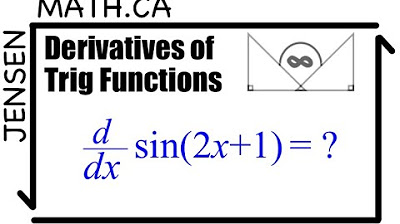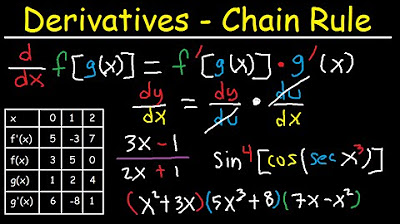AP Calculus AB and BC Unit 3 Review [Differentiation: Composite, Implicit, and Inverse Functions]
TLDRThis comprehensive video script covers essential calculus concepts, focusing on derivative rules such as the chain rule, product rule, quotient rule, and their application to composite functions. It delves into implicit differentiation, emphasizing its importance for related rates problems and provides strategies for solving inverse function derivatives. The script also touches on higher-order derivatives, offering insights into twice differentiable functions and the process of finding second derivatives for both explicitly and implicitly defined functions.
Takeaways
- 📚 The video provides a worksheet and practice problems for AP Calculus, including unit 2 on derivative rules like power, product, and quotient rules.
- 🔄 Unit 3 focuses on implicit differentiation, which is crucial for related rates problems in unit 4 and the chain rule, used throughout the course, especially in unit 6 for integration.
- 📈 The chain rule is essential for differentiating composite functions, explained through examples involving trigonometric, exponential, and power functions.
- 🤝 The chain rule often works in conjunction with other derivative rules like quotient rule, product rule, and power rule, especially for complex rational functions.
- 🔄 Implicit differentiation involves differentiating both x and y as variables, but after differentiating y, the result must be multiplied by dy/dx due to the function's dependency.
- 📌 When differentiating inverse functions, the x and y values are swapped, and the process involves finding the inverse function and evaluating it at a given point.
- 🔄 For inverse trig functions, memorize the derivative formulas and apply them by substituting the correct x and using the chain rule if necessary.
- 📈 To determine which derivative rules to use, start from the outside of the function and work towards the inside, considering the primary function type (e.g., rational, power, etc.).
- 🔢 Higher-order derivatives, such as second derivatives, are found by differentiating the first derivative again, using the same rules applied to the original function.
- 📝 When dealing with implicitly defined functions, replace any occurrence of the first derivative in the second derivative with the derived first derivative function for accurate results.
Q & A
What is the main focus of Unit 3 in the context of AP Calculus?
-Unit 3 focuses on learning and applying the chain rule, which is crucial for differentiating composite functions, as well as understanding implicit differentiation and its application in solving related rates problems.
How does the chain rule apply to composite functions?
-The chain rule states that to differentiate a composite function, you first take the derivative of the outer function and then multiply by the derivative of the inner function. It is applied in two steps: first, differentiate the outside function ignoring the inside function, and second, multiply by the derivative of the inside function.
What are some of the derivative rules mentioned in the script that are essential for Unit 3?
-The script mentions the power rule, product rule, quotient rule, and the chain rule as essential for differentiating various types of functions in Unit 3.
How is the derivative of an exponential function handled according to the script?
-The derivative of an exponential function is the same as the original exponential function itself. For example, the derivative of e^(X cubed + 2x) is still e^(X cubed + 2x).
What is the significance of the chain rule in the context of the AP Calculus exam?
-The chain rule is significant because it is used frequently on the AP Calculus exam, especially when differentiating composite functions. Understanding and applying the chain rule correctly is crucial for success in the exam.
How does the script describe the process of differentiating inverse functions?
-The script describes the process of differentiating inverse functions by first swapping the x and y variables in the function, then solving for y, and finally evaluating the inverse function at a specific point if required.
What is the relationship between the slopes of corresponding points on inverse functions?
-The slopes of corresponding points on inverse functions are reciprocals of each other. This is due to the symmetry of the functions over the line y equals x.
How can you find the derivative of a function that is the inverse of a given function?
-To find the derivative of a function that is the inverse of a given function, you use the relationship that the derivative of the inverse function at a point is the reciprocal of the derivative of the original function at the corresponding point.
What are higher-order derivatives and how are they calculated?
-Higher-order derivatives are derivatives of the first derivative. They are calculated by differentiating the first derivative to obtain the second derivative, differentiating the second derivative to obtain the third derivative, and so on.
How do you handle the derivative of an implicitly defined function when finding higher-order derivatives?
-When finding higher-order derivatives of an implicitly defined function, you first differentiate the function to find the first derivative, then differentiate that first derivative to find the second derivative, and so on. You also need to replace any instances of the first derivative within the higher-order derivative with the actual expression derived from the first differentiation.
What is the quotient rule and how is it applied in the script?
-The quotient rule is a derivative rule that states to find the derivative of a quotient, you take the derivative of the numerator times the denominator minus the numerator times the derivative of the denominator, all divided by the denominator squared. In the script, it is applied when dealing with rational functions, where the function is a quotient of two other functions.
Outlines
📚 Introduction to Unit 3 and Review of Derivative Rules
This paragraph introduces Unit 3 of the course, emphasizing the importance of understanding chain rule and implicit differentiation, which are critical for solving related rates problems in Unit 4 and for the AP Calculus exam. It reviews the concepts learned in Unit 2, including derivative rules such as power, product, and quotient rules, and the derivatives of trigonometric, logarithmic, and exponential functions. The paragraph also highlights the significance of composite functions and the two-step process of the chain rule for differentiation.
🔄 Applying Chain Rule and Other Derivative Rules
The paragraph delves into the application of the chain rule, alongside other derivative rules like quotient, product, and power rules, for more complex functions. It explains the process of differentiating composite functions, which involves taking the derivative of the outer function first and then multiplying by the derivative of the inner function. The paragraph also provides an example of a rational function and demonstrates how to build an outline for differentiation, emphasizing the importance of organizing the process to avoid confusion and ensure accuracy.
📝 Implicit Differentiation and Differentiating Y with Respect to X
This section focuses on the process of implicit differentiation, where the relationship between x and y is not explicitly given. It explains the two-step process for differentiating y with respect to x, which involves first treating y as a variable and then applying the chain rule by multiplying by y' (dy/dx). The paragraph provides examples to illustrate how to differentiate functions like 3x^2 and e^y, and how to handle the derivative of y in terms of x after the initial differentiation. It also touches on the importance of remembering the two parts of the process when differentiating implicitly defined functions.
🔢 Solving for dy/dx and Differentiating Inverse Functions
The paragraph discusses the process of solving for dy/dx in implicitly defined functions, emphasizing the need for careful sign management, especially when the AP exam might present equivalent expressions with different sign arrangements. It then transitions into differentiating inverse functions, explaining that inverse functions are reflections of each other over the line y=x, with swapped x and y values. The paragraph provides a step-by-step guide on how to find the inverse function evaluated at a particular point and how to use the relationship between inverse functions to find the derivative of one function when the derivative of its inverse is known.
📌 Memorizing Derivative Formulas for Inverse Trig Functions
This section emphasizes the importance of memorizing the derivative formulas for inverse trigonometric functions, such as arcsine, arccosine, arctangent, and their reciprocals, for efficient problem-solving during the AP exam. It outlines the correct application of these formulas, including the need to replace the variable X with the given argument and to apply the chain rule if the argument is not X. The paragraph provides a clear example of how to differentiate an inverse cosecant function with an argument of 3x^2, demonstrating the correct application of the chain rule and the use of the correct X value.
🔍 Identifying and Applying Derivative Rules for Higher-Order Derivatives
The final paragraph of the script focuses on the strategy for identifying which derivative rules to apply when differentiating a function and the order in which to apply them. It explains the importance of working from the outside of the function towards the inside and provides an example of how to approach a complex rational function with multiple layers. The paragraph also introduces the concept of higher-order derivatives, specifically second derivatives, and explains that they are the derivative of the first derivative. It concludes with a reminder to use the same derivative rules for higher-order derivatives as for the first derivative and to plug in the first derivative when differentiating implicitly defined functions.
Mindmap
Keywords
💡Derivative Rules
💡Composite Functions
💡Chain Rule
💡Implicit Differentiation
💡Related Rates Problems
💡AP Calculus
💡Inverse Functions
💡Higher-Order Derivatives
💡Applications of Differentiation
💡Trigonometric Functions
Highlights
Worksheets and practice problems are provided for AP Calculus preparation.
Unit 2 covers derivative rules like power, product, and quotient rules.
Unit 3 introduces the derivatives of trig, log, and exponential functions.
Implicit differentiation is crucial for related rates problems in Unit 4.
The chain rule is fundamental for differentiating composite functions and is frequently used throughout the course.
The chain rule involves taking the derivative of the outside function first, ignoring the inside function.
The second step of the chain rule is multiplying by the derivative of the inside function.
Composite functions are functions of other functions, such as f(x) = (x^3 + 2x) nested inside g(x) = sin(x).
The chain rule must often be combined with other derivative rules, like quotient and power rules, for complex functions.
Differentiating implicitly defined functions involves treating y as a variable first, then applying the chain rule.
For implicitly defined functions, the first derivative is represented as dy/dx or Y prime.
The second derivative of an implicitly defined function requires plugging the first derivative into itself.
Inverse functions are reflections of each other over the line y=x, with swapped x and y values.
To find the inverse function evaluated at a point, swap x and y in the original function and solve for y.
For inverse functions that are differentiable, the product of the derivative of one function and the derivative of its inverse at corresponding points is always 1.
Memorizing the derivative formulas for inverse trig functions is recommended for efficiency during the AP exam.
When differentiating a function, work from the outside towards the inside to determine the order of applying derivative rules.
Higher-order derivatives, such as second derivatives, are found by differentiating the first derivative.
Twice differentiable functions have both the original function and its first and second derivatives defined.
Transcripts
Browse More Related Video

Business Calculus - Math 1329 - Section 2.3 - Product and Quotient Rules; Higher-order Derivatives

DERIVATIVES that keep getting HARDER 🤯 | jensenmath.ca

Derivatives of Trig Functions - Calculus | MCV4U

Derivatives for Beginners - Basic Introduction

Math 11 - Sections 1.7-1.8

Derivatives of Composite Functions - Chain Rule, Product & Quotient Rule
5.0 / 5 (0 votes)
Thanks for rating: